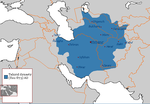Al-Husayn ibn Isma'il al-Mus'abi
Al-Husayn ibn Isma'il al-Mus'abi | |
|---|---|
Fars | |
| In office 850 - 861 | |
| Monarch | Al-Mutawakkil |
| Preceded by | Muhammad ibn Ibrahim |
| Chief of security (Shurtah) in Baghdad | |
| In office 870 - 885 | |
| Monarch | Al-Mu'tamid |
| Personal details | |
| Born | unknown date Abbasid Caliphate |
| Died | 885 Baghdad, Abbasid Caliphate |
| Parent | Isma'il ibn Ibrahim ibn Mus'ab |
| Military service | |
| Allegiance | Abbasid Caliphate |
| Years of service | 861 - 867 |
| Battles/wars | Fifth Fitna |
Al-Husayn ibn Isma'il ibn Ibrahim ibn Mus'ab (
Career
A member of the Mus'abid family, al-Husayn was a blood relation of the
Following the death of al-Mutawakkil in 861, al-Husayn returned to
After the end of the war al-Husayn appears to have remained in the service of Muhammad until the latter's death in 867, and he participated in the suppression of a troop riot in Baghdad in 866.
In 870 al-Husayn is mentioned as overseeing the seasonal festival (mawsim) during the pilgrimage of that year.[9] He later held the office of chief of security (shurta) of Baghdad on behalf of Muhammad ibn Tahir in 885, during which time he protected a local monastery from being destroyed by a mob.[10]
Notes
- ^ Ibn 'Asakir 1995–2000, v. 14: p. 44.
- ^ Al-Ya'qubi 1883, p. 621; Ibn 'Asakir 1995–2000, v. 14: p. 44.
- ^ Al-Tabari 1985–2007, v. 34: pp. 108-09; Al-Ya'qubi 1883, p. 621; Bosworth 1975, p. 102.
- ^ Ibn 'Asakir 1995–2000, v. 6: p. 384; v. 14: p. 44; Cobb 1999, p. 255.
- ^ Al-Tabari 1985–2007, v. 35: pp. 17-21; Al-Ya'qubi 1883, p. 608;Ibn 'Asakir 1995–2000, v. 14: p. 44; Zetterstéen & Bosworth 1993, p. 390.
- ^ Al-Tabari 1985–2007, v. 35: pp. 45, 47, 71, 78-86, 92; Kennedy 2001, p. 202.
- ^ Al-Tabari 1985–2007, v. 35: pp. 127-30.
- ^ Al-Tabari 1985–2007, v. 36: pp. 16-21.
- ^ Al-Ya'qubi 1883, p. 621.
- ^ Al-Tabari 1985–2007, v. 37: p. 148.
References
- ISBN 0-521-20093-8.
- S2CID 162218899.
- Ibn 'Asakir, Abu al-Qasim 'Ali ibn al-Hasan ibn Hibat Allah(1995–2000). al-'Amrawi, 'Umar ibn Gharama (ed.). Tarikh Madinat Dimashq (in Arabic). Vol. 80 vols. Beirut: Dar al-Fikr.
- ISBN 0-415-25093-5.
- Al-Tabari, Abu Ja'far Muhammad ibn Jarir(1985–2007). Ehsan Yar-Shater (ed.). The History of Al-Ṭabarī. Vol. 40 vols. Albany, NY: State University of New York Press.
- Al-Ya'qubi, Ahmad ibn Abu Ya'qub (1883). Houtsma, M. Th. (ed.). Historiae, Vol. 2(in Arabic). Leiden: E. J. Brill.
- ISBN 90-04-09419-9.

